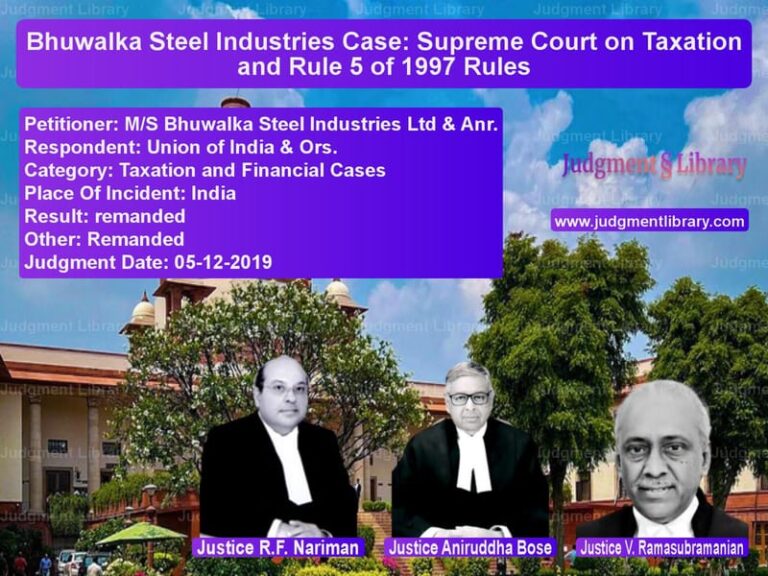Bank Withheld Deposits: Supreme Court Rules on Limitation for Counter-Claims
The Supreme Court of India recently delivered a judgment in the case of Topline Shoes Limited & Another vs. Punjab National Bank, clarifying the legal position regarding counter-claims and the applicability of the **Limitation Act, 1963**. The case revolved around whether the counter-claim made by Topline Shoes Limited against Punjab National Bank was barred by limitation.
Background of the Case
The dispute arose when **Topline Shoes Limited**, the appellant, had deposited an amount in a **current account** with **Punjab National Bank**. The company later alleged that the bank had illegally withheld the deposited sum. This led to the filing of **O.A. No.948 of 2000** before the **Debt Recovery Tribunal (DRT)**, wherein the bank raised claims against the company. The company, in response, filed a **counter-claim**, asserting that the bank had wrongfully withheld its money.
After a prolonged legal battle, the **DRT dismissed both the bank’s claim and the company’s counter-claim**. Both parties appealed before the **Debt Recovery Appellate Tribunal (DRAT)**, which upheld the DRT’s decision. Dissatisfied with the ruling, Topline Shoes Limited approached the Bombay High Court, which dismissed its writ petition on grounds of **limitation**.
Petitioner’s Arguments
The petitioners, Topline Shoes Limited and another, argued that:
- The company’s deposited amount was **wrongfully withheld** by Punjab National Bank.
- Since the amount was **not a security or fixed deposit**, the bank had **no right to withhold it**.
- The limitation period should be governed by **Article 22 of the Limitation Act**, which provides for a three-year period from the date a demand is made.
- The company **sent a legal notice in September 1999**, which should be treated as the starting point for the limitation period.
- Since the counter-claim was filed in 2000, it was **within the limitation period** and should have been entertained.
Respondent’s Arguments
Punjab National Bank defended its case by arguing:
- The counter-claim was **barred by limitation** and fell under **Article 113 of the Limitation Act**, which provides a **three-year limitation from the date when the right to sue accrues**.
- The company had **consciously decided not to challenge the bank’s actions** in 1994, despite considering legal recourse at that time.
- The legal notice sent in **1999** could not **restart the limitation period**, as the cause of action arose much earlier.
- The High Court, DRT, and DRAT had **rightly concluded that the counter-claim was time-barred**.
Supreme Court’s Observations
The Supreme Court carefully examined the facts and the **applicability of the Limitation Act** to the counter-claim. The court made the following key observations:
- The claim of undue influence and coercion was raised belatedly, after a lapse of **more than five years**.
- The company’s **board of directors had discussed the possibility of litigation but chose not to pursue legal action** in 1994.
- The company’s argument that the limitation period began in **1999** (when the legal notice was issued) was **flawed**, as the cause of action arose when the bank allegedly withheld the money.
- The DRT, DRAT, and High Court had **rightly held that the counter-claim was covered under Article 113**, not Article 22, of the Limitation Act.
Key Legal Precedents Referenced
The Supreme Court relied on the following legal precedents:
- Jammu & Kashmir Bank Ltd. v. Attar-Ul-Nissa (1967): Clarified the **application of the Limitation Act** to claims arising out of bank deposits.
- Devendra Pratap Narain Rai Sharma v. State of Uttar Pradesh (1962): Established that **mere delay in raising claims cannot revive a cause of action**.
- Union of India v. Madhusudan Prasad (2004): Held that **limitation laws must be strictly applied** to prevent stale claims.
Final Judgment
Based on these findings, the Supreme Court ruled:
- The counter-claim was **barred by limitation** under **Article 113** of the **Limitation Act, 1963**.
- The legal notice issued in 1999 **did not extend or restart** the limitation period.
- Topline Shoes Limited had **consciously chosen not to challenge the bank’s actions in 1994**, which barred them from seeking relief after so many years.
- The appeals were dismissed, and the judgment of the **Bombay High Court was upheld**.
With this ruling, the Supreme Court reaffirmed the **strict application of limitation laws** in financial disputes, ensuring that claims must be brought within the prescribed timeframe.
Petitioner Name: Topline Shoes Limited & Another.Respondent Name: Punjab National Bank.Judgment By: Justice B.R. Gavai, Justice Pamidighantam Sri Narasimha.Place Of Incident: Mumbai, Maharashtra.Judgment Date: 19-07-2022.
Don’t miss out on the full details! Download the complete judgment in PDF format below and gain valuable insights instantly!
Download Judgment: topline-shoes-limite-vs-punjab-national-bank-supreme-court-of-india-judgment-dated-19-07-2022.pdf
Directly Download Judgment: Directly download this Judgment
See all petitions in Debt Recovery
See all petitions in Contract Disputes
See all petitions in Banking Regulations
See all petitions in Judgment by B R Gavai
See all petitions in Judgment by P.S. Narasimha
See all petitions in dismissed
See all petitions in supreme court of India judgments July 2022
See all petitions in 2022 judgments
See all posts in Civil Cases Category
See all allowed petitions in Civil Cases Category
See all Dismissed petitions in Civil Cases Category
See all partially allowed petitions in Civil Cases Category







